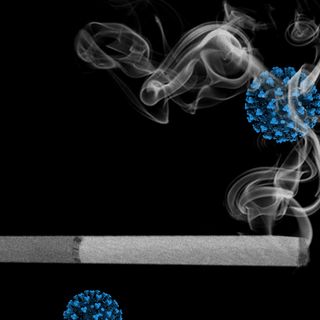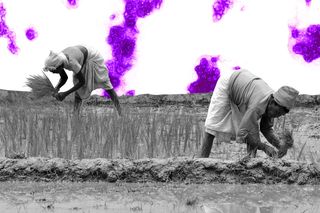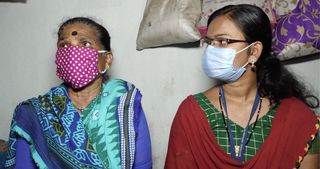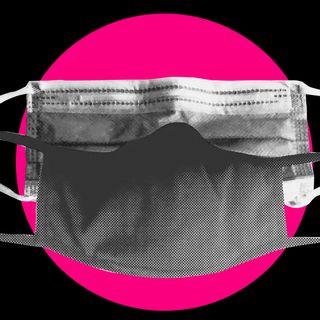
When Tropical Diseases Cause Disabilities, Exposed Women Face Increased Stigma
Without community support, women with filaria are unable to seek healthcare, secure employment, and maintain their sense of self-worth.

This is the second report in a four-part series that explores the social determinants of living with and in proximity to lymphatic filariasis, a neglected tropical disease.
Shortly after Sabita Behera’s leg started swelling, her husband left the village.
“He found someone and abandoned me,” she says, “I lived on my own and looked after myself and found family in the community.” After her husband left, Behera had to fend for herself and found a job washing dishes to make ends meet. However, living with lymphatic filariasis (filaria) made steady employment a complex issue. Acute filarial attacks, or periods of severe, localized inflammation, can cause debilitating pain and bacterial infections, leading to days, or even weeks, of lost employment.
“When my leg is better I can work and when it is not I am down on the bed. I give some money to the people around me to fetch my medicines, which help me feel better and recover,” adds Behera, who lives in Odisha’s Ganjam District. “No one is around to help me or look after me and enquire about my well-being. My family has offered no support and told me to look after myself.”

Sabita Behera sits with Rosy Kumari Behera, a health officer. Photos by Srikanta Jena, Santanu Shou
Living with filaria, a neglected tropical disease (NTD) that causes a highly visible disability, is a gateway to stigma and social isolation. While filaria may not have a medically higher prevalence in women, they are still more likely to be exposed to it due to gender roles. “We know that women tend to be at a disadvantage in terms of exposure, burden, and morbidity from NTDs,” Alexandra Wharton-Smith, from the London School of Hygiene and Tropical Medicine, U.K., states in a paper published in the medical journal Lancet Infectious Diseases.
Related on The Swaddle:
Rural Health Centres Lack 76% Of Specialist Doctors They Need: Govt Report
Filaria primarily spreads via dirty water and the mosquitoes that teem around it. “Ladies do all kinds of menial work, like washing clothes, utensils, cooking, bathing their children, looking after the cattle,” says Dr. Ritu Shrivastava, a district malaria officer in RaeBareli, Uttar Pradesh. “All these places have water-logging and mosquitoes. So women become the primary victims of these diseases.”
The greatest struggles for women who live with diseases like filaria is the loss of self-image and self-esteem due to inability to showcase usefulness.
Beyond a significant likelihood of exposure, the social conditions of marginalized women ensure there is severe underreporting of the disease. Women also suffer due to a lack of information around how the disease spreads and due to having little say in family healthcare decisions.
Behera, now 60, has lived with filaria for 16 years. When her leg started swelling, she did not know it could be filaria — she merely took random medication in order to reduce her swelling, fevers, and distress. One day, she couldn’t walk and had to rely on her neighbors to take her to the hospital. There, she was finally told that she had filaria, and had to undergo an operation to extract fluid from her leg because the disease had become so severe the doctor deemed it life-threatening.
Her story is quite similar to that of several women, according to research published in the journal Social Science and Medicine. Researcher Lalita Bandhopadhyay has found that only 30% of the people who go to health clinics in the observed areas (including Odisha) are women, with 55% of those being married women aged 20-44. Almost 80% of younger girls received diagnoses via home visits from doctors, who only found out about their situation after questioning male relatives who had visited the clinic. The shame of large inflammations in women’s bodies, especially in genitalia and chest regions, makes it significantly harder for women and healthcare workers to overcome awkwardness and focus on treatment. In this case, treatment is delayed until problems become severe.
“Gender is a definite determinant that influences both health and access to health care. Poor literacy levels of women, the extreme dependence on men to travel/access primary health care and also the overwhelming household responsibilities are some of the contributing factors,” says Dr. Asha Banu Soletti, a professor at the Centre for Health and Mental Health at the Tata Institute of Social Sciences, Mumbai. She adds, “As part of one of my research projects, we were assessing the levels of awareness of men, women and adolescent children on HIV and STIs. [We found that] the awareness levels of men and adolescents were higher than that of women. The reason is that none of the modes of health communication reached women. Due to poor literacy levels, they could not read the print material. Due to no electricity, they [also] could not see campaigns on television or radio.”
“Women’s health needs are numerous and often interrelated,” says Nidhi Dubey, a senior vice president at Global Health Strategies. “In the NTD landscape, there is an underestimation and underreporting of NTDs in women, specifically schistosomiasis and lymphatic filariasis, as diagnosis can require women to comply with activities that are perceived as culturally inappropriate, like providing a urine or stool sample or allowing intimate physical examination. Studies have also indicated that women in traditional rural settings prefer women physicians, especially for reproductive and sexual health conditions that are considered of an intimate nature, sensitive, or associated with shame or stigma. Women believe that women physicians better understand and respond to their needs. However, access to women physicians in rural India is particularly challenging, as there is a chronic shortage of women doctors in rural settings, which are often considered remote posts fraught with difficulties, and hence, seldom taken up.”
Related on The Swaddle:
On the Brahmaputra’s Islets, Health Care Is as Unreliable as the Ground Underfoot
Gender hierarchies also influence drug hesitancy during Mass Drug Administration (MDA) rounds, that is, the annual distribution of preventative medication against filaria. Research conducted in India and several other low- and middle-income countries that struggle with eliminating filaria show that men had power and control over whether women would take the drugs, due to greater access to literacy and social power. “A primary challenge that I face during MDA in RaeBareli is that the ladies will not take the medication unless the husbands or elders in the family co-operate. If these elders are not around, then the entire family gets left out. And if you have two or three families like this in a lane, then you’ve broken the chain of administering these drugs,” Dr. Shrivastava says.
The greatest struggles for women who live with diseases like filaria is the loss of self-image and self-esteem due to the inability to showcase usefulness. India’s gender roles dictate that women’s value resides in their ability to contribute to the household or their ability to attract marital proposals, and a lack of both leads women to think of themselves as burdens to society and family. This is further exacerbated by abandonment from family, partners, and community due to stigma. This, in a way, further affects women’s ability to receive treatment from healthcare workers. “Since desertion of women for second marriages are both easy and common in rural areas, women tend to hide their health problems rather than asserting or negotiating their rights,” Dr. Soletti adds.
Reversing community stigma, therefore, is a necessary means to provide aid and agency to women — a fact well known to the women who work in health care at anganwaadis. “The most powerful of all interventions is the fact that female community drug administrators — the backbone of our rural health delivery system in India, (i.e.) ASHA’s, ANMs and anganwadi workers — are reaching millions through many national programs being run by the Ministry of Health,” Dubey says. “Evidence supported that NTD programs are strengthened when female community drug administrators are trained well and equipped with the tools they need to reach out to communities and convince them to accept preventive and promotive services. When we examine Mass Drug Administration programs through a gender equity lens, they (women) have the potential to serve as a vehicle to promote female empowerment and also address the chronic challenge of poor access to women physicians in rural India.”

A group of health workers in Ganjam, Odisha. Srikanta Jena, Santanu Shou
Beyond just access, women healthcare workers bring a unique knowledge of community stigma and a powerful, infectious belief in other women’s capabilities. “If their husband dies, leaves them, or abuses them [because of the disease], they should never break down and always have hope,” says K. Suryakantha, an anganwaadi worker. Ranjeeta, another anganwadi worker, adds, “We usually call the women in the family for meetings. Because, if the lady of the house is educated and aware, she will spread the awareness to the entire family. So, we give her more importance than the men of the family. If we educate her, she can educate the entire village, too.”
Odiya and Telegu translations by Sangeet Anshuman and Sourav Pattanaik
Aditi Murti is a culture writer at The Swaddle. Previously, she worked as a freelance journalist focused on gender and cities. Find her on social media @aditimurti.
Related


There’s a Right Way To Double Mask Against Covid19, Research Shows
